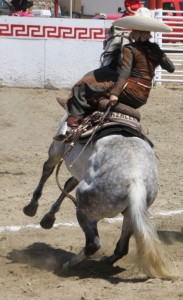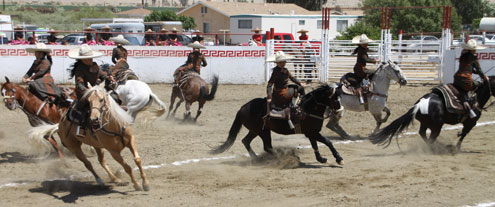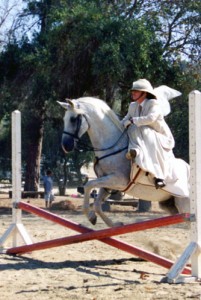Sidesaddle Riding Thrives in Modern World
By Melodee M. Spevak May 19, 2011Many ancient disciplines have made their way into the modern world despite having lost their original, practical necessity. In today’s mechanized society, almost all horse activities could be said to fall into this category, but few retain the charm and grace of a bygone age as completely as the art of sidesaddle riding.
The elegance and historical significance of sidesaddle has attracted modern riders of all disciplines and created a surprisingly diverse group of participants.
Here in California, Western sidesaddles are often seen in both the lighter duty Western Pleasure and sturdy Western Stock constructions. In the show ring, period costumes with a full skirt or an apron over Western pants and chaps are used, often with a bolero and Western hat. While not all shows accept sidesaddles, many do, and the results can be fascinating for both participants and observers.
Lillian Chaudhary, a longtime Western aside rider, member of the Sidesaddle Hall of Fame and saddle maker, has been involved with the discipline since her teens. “I love riding aside,” she says. “It is very comfortable and secure, and it is feminine and graceful. It is from a time when women were ladies. We could use that again these days.”
Riding “aside,” in its most basic form, dates from the days of ancient Greece. It continued in various forms from early Celtic times and through the Middle Ages (where riding pillion—aside and behind a man—gave a lady no role, other than that of passenger). The first functional sidesaddle is said to have been the brainchild of Anne of Bohemia in the 14th century, setting the scene for women to ride without the immodest necessity of sitting astride.

Las Azaleas team captain Maribel Guiterrez executes a turn on Centenario. (Photo by Jodi Champagne / Pony Highway Prods.)
The concept was still far from safe, more of a chair than a saddle, in a design that had the woman riding sideways. By the 16th century, the design had the rider facing forward, but it was the addition of a second pommel (horn) in the 1800s that for the first time gave a rider the security to truly control a horse. This “leaping horn” opened the door for ladies to ride at a gallop and over fences, putting them on a par with their male counterparts while still conforming to society’s sense of propriety.
Today, this style is still the one most commonly in use for sidesaddle riding, whether recreational, competitive or therapeutic (sidesaddle has been used in the rehabilitation of both male and female amputees in military hospitals as well as civilian life).
Chaudhary has built sidesaddles to help those with disabilities. “There are handicapped riders who are using sidesaddles because they cannot ride any other way. I built a sidesaddle with the horns on the right side for a lady who lost her right leg below the knee to bone cancer. It gave her a new lease on life. She would ride every weekend that she could.”
The basic sidesaddle design has been used in California since the arrival of the Europeans and is an intrinsic part of the history of women in the American West. In Mexican-style rodeos, the women in Escaramuza Charra drill teams perform complicated patterns at high speed. They ride aside, or “to mujeriegas,” in a saddle known as an albarda. The word escaramuza (skirmish) points up the edge of danger in the quick, complex maneuvers often performed on horses with reining training. The precision of the team, coupled with the sheer beauty of their appearance, makes for a thrilling and colorful presentation at many events. Traditional costumes with layers of petticoats under decorated skirts or breeches and jackets are the usual garb. Escaramuza Charra is extremely popular in Southern California and a crowd favorite.
Pony Highway, an Antelope Valley-based production company, is in the final stages of editing a documentary on this discipline that will be available later in 2011. Escaramuza: Riding From The Heart features the Las Azaleas team, which represented California and the U.S. at the National Charro Championships in Mexico (www.ponyhighway.com/emz.html).
English sidesaddle competitors are usually turned out in formal attire with habit, helmet or hat and long skirts. Competition at shows includes both flat and hunt classes. Southern California riders Margie Beeson and Eloise King have appeared in a sidesaddle pas de deux at events like the Equine Affaire in a romantic re-creation of Victorian elegance. (You can see them at www.youtube.com/watch?v=-L8gzgdSjds.)
Beeson traces her love of the discipline to her mother’s influence. “I grew up as a tomboy, but I guess my mother won out on some of her training to make me a lady. There is nothing like the beauty and flow of a lady on a sidesaddle.”
Sidesaddle jumping is another sport and not one for the faint of heart. The current world record for sidesaddle jumping has stood since 1915, when Esther Stace, of Australia, cleared a record 6’6” at the Sydney Royal Show, leaving little doubt of the courage of aside equestriennes.
You can see California sidesaddle riders in action at the Southern California Peruvian Paso Horse Club Pacific Coast Championship Show in Ventura, June 4 and 5, as well as at the Arabian Horse Association Region 1 Championships in Del Mar, the Arabian Horse Association of the San Fernando Valley Thanksgiving show at the L.A. Equestrian Center and annually at the Fiesta of the Spanish Horse.
For more information on the art of riding sidesaddle, contact the American Sidesaddle Association, at www.AmericanSidesaddleAssociation.org, and CA ASIDE, at http://sports.groups.yahoo.com/group/CA_Aside/.
Short URL: https://theequestriannews.com/?p=1615




